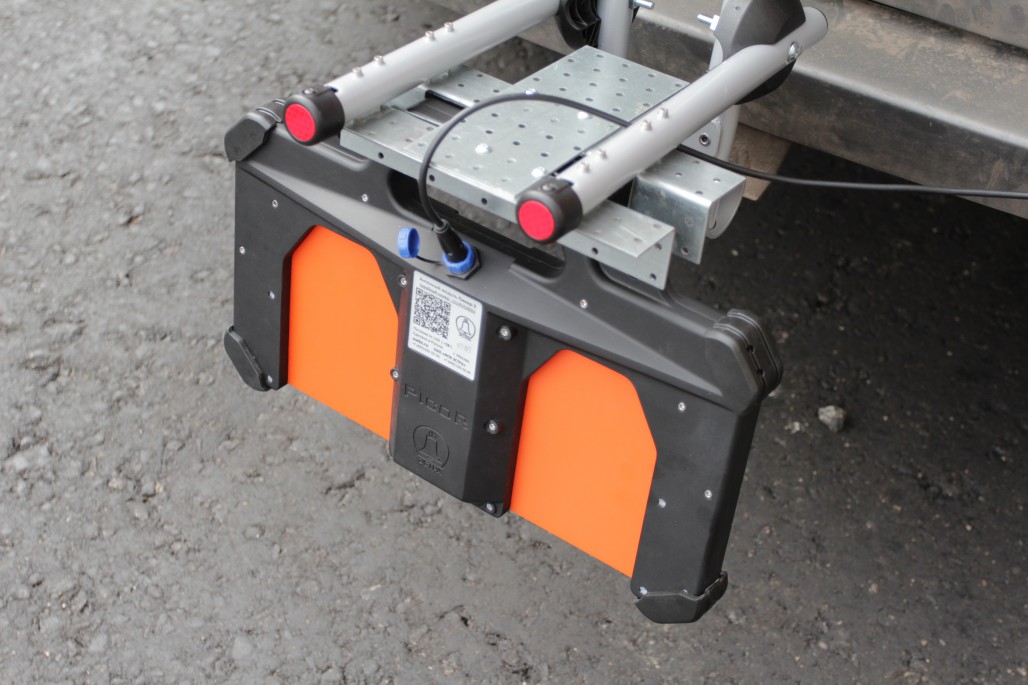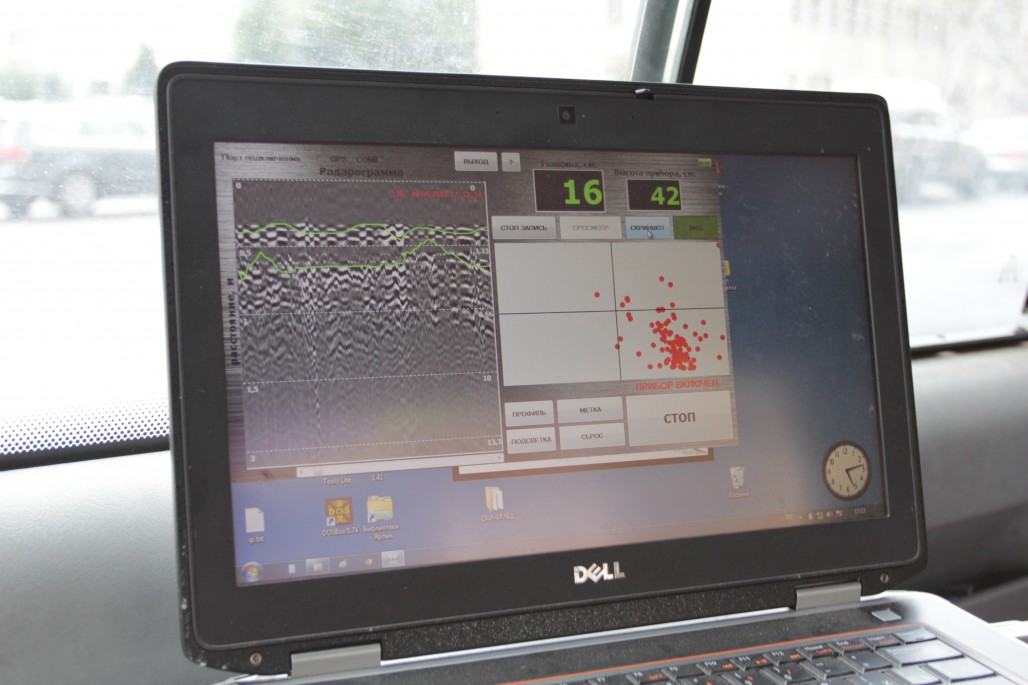 |
Device for picor-Avtodor road surface survey
The Pikor-Avtodor pavement inspection device is a high-resolution ground penetrating radar
adapted for use to determine the thickness of asphalt concrete pavement and the condition of
pavement, namely: - the thickness of asphalt concrete pavement in real time in automatic mode (on
road sections whose structure satisfies the model described in the software) and in the manual post-
processing mode (in other areas); - the condition of the pavement (the quantity and uniformity of
asphalt concrete layers, horizontal structural changes); - type of the base of the roadway (concrete
- crushed stone - reinforced concrete); - sections of pavement, the structure of which differs from
the design (abrupt change in the thickness of the same type of road structures or the presence of
different types of road structures in one section, a change in the type of base)
Part number:
Supplier:
JSC SozvezdieDescription
Specifications:
Determined thickness of asphalt and road structures: up to 1 m
Vertical accuracy: 1 cm
Maximum laboratory speed: 40-60 km / h
The separation height of the display module from the road surface: 15-30 cm
Accuracy of determination of coordinates in the autonomous mode: 2.5 m
Sector of review: 60th hail. in the horizontal plane, 80 degrees. in the vertical plane
dimensions
indicating module: 410 x 270 x 68 mm
Display module weight: 1.8 kg
Battery life
(with laptop): up to 4 hours
Operating temperature range: -20 ... +50 ° С
The Pikor-Avtodor device can be used both as part of a road laboratory along with other means of
examination (for example, GPR with a lower central frequency, lower resolution and greater depth),
and separately. The device is mounted on a vehicle (car) and allows inspection when driving in a
stream of cars at speeds up to 40-60 km / h. It is possible to use several indicator modules of the
device simultaneously for examining the entire lane and building sections of the roadway.
The Pikor-Avtodor device allows automatic inspection of the pavement (on road sections whose
structure satisfies the model described in the software), yielding the value of asphalt thickness and
other parameters, and does not require a geophysicist to interpret geophysical data. On difficult
sections of the roadway, the device operates in the mode of recording information for further post-
processing by specialists and issuing a report.
Thus, the device allows you to evaluate the condition of the roadway in great length in real time in
order to control the structure of pavement and significantly reduce the complexity of the work,
compared with other existing methods.
The main consumers of the device:
- road services performing construction and repair of the roadway;
- organizations involved in the operation of roads;
- organizations that control road repairs;
- survey and design organizations carrying out work for design and construction.
The device is required by the listed organizations for a quick and non-destructive method for
examining pavement. Existing survey methods are currently represented mainly by drilling. This method does not provide continuous profile information on changes in the structure of pavement, it
is laborious and requires paperwork for work on the roadway.
The high cost of similar GPR type devices does not allow responsible organizations to purchase
them in bulk. At the same time, the several times lower cost of the Pikor-Avtodor device will allow
organizations that have not previously had the opportunity to purchase more expensive analogues to
use it.
The device includes:
- multifunctional display module Pikor-2;
- a laptop computer type Windows-based laptop with field software SKI-Avtodor;
- GPS navigation GLONASS receiver;
- USB cables and USB extension cords for data transmission and power supply of the antenna
module and navigation receiver;
- fastening the antenna module to the towbar of the car;
- stationary software for processing recorded signals, overlaying data on a map and exporting data
for processing in other programs;
- passport and operation manual.
Main features and advantages of the device over analogues:
1) Determination of the thickness and structure of road structures to a depth of 1 m. Data is captured
by the profiling method when the vehicle (laboratory) moves along the road.
2) The display module of the device is a monoblock. The USB cable transfers data to a laptop
(tablet). The laptop is located inside the machine, additional information is transmitted to it with a
navigation reference to the observation profile;
3) Power to the display module is supplied from a laptop (tablet), which can be powered from the
car network;
4) The maximum laboratory speed is 40-60 km / h. Frequency of updating information data - no
worse than 1 implementation per 10 cm;
5) Vertical accuracy - at least 1 cm;
6) The ability to work with the separation of the display module from the road surface by 15-30 cm;
7) The display module can be mounted on a tow bar, on a bar with a wheel, etc.
8) Positioning is carried out using a GPS-GLONASS receiver;
9) It is possible to install a number of indicator modules on one holder for strip georadar-tracking
surveys with the aim of profiling a whole lane.
10) Automatic signal processing, separation of layer boundaries and automatic calculation of layer
thicknesses;
11) The small size and weight of the device makes it easy to transport it to one person;
12) Comparatively low cost, 2-5 times less than the cost of the closest analogues.
Determined thickness of asphalt and road structures: up to 1 m
Vertical accuracy: 1 cm
Maximum laboratory speed: 40-60 km / h
The separation height of the display module from the road surface: 15-30 cm
Accuracy of determination of coordinates in the autonomous mode: 2.5 m
Sector of review: 60th hail. in the horizontal plane, 80 degrees. in the vertical plane
dimensions
indicating module: 410 x 270 x 68 mm
Display module weight: 1.8 kg
Battery life
(with laptop): up to 4 hours
Operating temperature range: -20 ... +50 ° С
The Pikor-Avtodor device can be used both as part of a road laboratory along with other means of
examination (for example, GPR with a lower central frequency, lower resolution and greater depth),
and separately. The device is mounted on a vehicle (car) and allows inspection when driving in a
stream of cars at speeds up to 40-60 km / h. It is possible to use several indicator modules of the
device simultaneously for examining the entire lane and building sections of the roadway.
The Pikor-Avtodor device allows automatic inspection of the pavement (on road sections whose
structure satisfies the model described in the software), yielding the value of asphalt thickness and
other parameters, and does not require a geophysicist to interpret geophysical data. On difficult
sections of the roadway, the device operates in the mode of recording information for further post-
processing by specialists and issuing a report.
Thus, the device allows you to evaluate the condition of the roadway in great length in real time in
order to control the structure of pavement and significantly reduce the complexity of the work,
compared with other existing methods.
The main consumers of the device:
- road services performing construction and repair of the roadway;
- organizations involved in the operation of roads;
- organizations that control road repairs;
- survey and design organizations carrying out work for design and construction.
The device is required by the listed organizations for a quick and non-destructive method for
examining pavement. Existing survey methods are currently represented mainly by drilling. This method does not provide continuous profile information on changes in the structure of pavement, it
is laborious and requires paperwork for work on the roadway.
The high cost of similar GPR type devices does not allow responsible organizations to purchase
them in bulk. At the same time, the several times lower cost of the Pikor-Avtodor device will allow
organizations that have not previously had the opportunity to purchase more expensive analogues to
use it.
The device includes:
- multifunctional display module Pikor-2;
- a laptop computer type Windows-based laptop with field software SKI-Avtodor;
- GPS navigation GLONASS receiver;
- USB cables and USB extension cords for data transmission and power supply of the antenna
module and navigation receiver;
- fastening the antenna module to the towbar of the car;
- stationary software for processing recorded signals, overlaying data on a map and exporting data
for processing in other programs;
- passport and operation manual.
Main features and advantages of the device over analogues:
1) Determination of the thickness and structure of road structures to a depth of 1 m. Data is captured
by the profiling method when the vehicle (laboratory) moves along the road.
2) The display module of the device is a monoblock. The USB cable transfers data to a laptop
(tablet). The laptop is located inside the machine, additional information is transmitted to it with a
navigation reference to the observation profile;
3) Power to the display module is supplied from a laptop (tablet), which can be powered from the
car network;
4) The maximum laboratory speed is 40-60 km / h. Frequency of updating information data - no
worse than 1 implementation per 10 cm;
5) Vertical accuracy - at least 1 cm;
6) The ability to work with the separation of the display module from the road surface by 15-30 cm;
7) The display module can be mounted on a tow bar, on a bar with a wheel, etc.
8) Positioning is carried out using a GPS-GLONASS receiver;
9) It is possible to install a number of indicator modules on one holder for strip georadar-tracking
surveys with the aim of profiling a whole lane.
10) Automatic signal processing, separation of layer boundaries and automatic calculation of layer
thicknesses;
11) The small size and weight of the device makes it easy to transport it to one person;
12) Comparatively low cost, 2-5 times less than the cost of the closest analogues.
